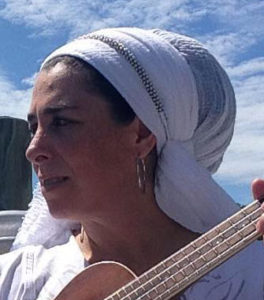
American-born Israeli. Tziona Achishena provided this autobiographical sketch: “Tziona’s Achishena’s rich and soulful voice weaves its way through her new disc, “Miriam’s Drum”, created in collaboration with percussionist Shani Ben Canar. The album features original melodies to ancient Hebrew prayers “received” through her intuitive musicianship, and enlivened by world class percussion, transcendent harmonies, and inspired vocal improvisation. The album’s release marks the culmination of years of musical and spiritual searching. Interestingly, this process began, not through music training, but through dance. From early childhood to her first years in college at Berkeley, Tziona spent much of her time in the dance studio, studying all the major western dance forms from Ballet to Modern dance. At home, however, she was singing; and experiencing through her voice the beginnings of a sense of the revelation of soul. Developing her vocal technique through private study and performing throughout high school, Tziona was inspired by great woman musicians like Joni Mitchell, Kate Bush and Laura Nyro; and dreamed of creating her own songs. While living in Indonesia studying traditional Indonesian dance, she learned how to play guitar and began a process of channeling the life experience through creative writing and songs. A few years later she encountered the improvisational music community in the San Francisco Bay Area, picked up the cello and piano, and began to improvise. “The Future” (1996), her first album, released under the name Zen Cohen, is a unique combination of these singer songwriter roots, through the prism of free improvisation. Cohen is a one-woman show who mixes folk singing, free improvisation and Eastern tonalities with pointed social commentary and raw poetry. Whether she is slashing away on an acoustic guitar, buzzing with a cello, or gently rocking a lullaby on a piano, the edge of her poetry-as-lyrics comes from sudden turns of phrase and plain speaking. Option Magazine A chance encounter with a master of Persian classical singing, Gholemhass Parishani, added yet another dimension to her music. Seeing her with her cello on the streets of Berkeley, he asked her to sing something for him. She sang a Javanese love song, and he began to cry. With a bit of convincing, he took her on as a vocal student for the next three years. Tziona’s creative life continued to develop, as she produced musical story theatres, studied Tai Chi and Sufi spinning, and appeared as a cellist in the John Cage premier “Ocean”. Connecting to her Jewish roots, she began to compose simple, repetitive melodies for ancient Hebrew prayers. Little did she guess the effect these melodies would have on her future. She began to share them with spiritual Jewish communities in the S.F. Bay area, and soon found herself leading large chanting groups, finding that her songs seemed to have a powerfully transformative effect on the participants. These melodies expressed the essence of the prayers, with strong rhythms and eastern tonalities that marked a break from the folk based traditions that had thus far been the main influence in original American Jewish music. The creation of these melodies is surprisingly simple; focusing the thoughts on the meaning of the prayer, focusing the eyes on the shape of the letters, and opening the heart, allowing the melody to be received. In 1999 she released the album “Hebrew Chant”, a two disc set that features “Shema Yisrael”, inspired by her work with patients at Mount Zion Medical center. Observing the dry clinical environment in which many of the patients ended their lives, she created the music as a passage between worlds. In the Shema Yisrael CD& in addition to beautifully haunting overdubs by Tziona, she is accompanied by exotic and rich Middle Eastern instrumentation. As a student chaplain at San Francisco s Mt. Zion hospital, she first began to compose and sing original melodies of the Shema to help heal and comfort sick and dying patients. When she realized the incredible power of Judaism s most ancient and central prayer, she began making recordings that could also be used for midwives and birthing mothers, welcoming new Jewish souls into the world. Dan Howard, Nitzotzot “The Hebrew Book of Ascending” (1999), recorded with Paul Godwin of the band Dogon and featuring percussion by Raz Mesinai (the artist known as Badawi) is a dreamlike journey through the seven heavens of the afterlife. The Flood (2000), recorded with sound designer James LeBrecht, is a genre-crossing whirlwind of classic songwriting, cinematic sound design, and powerful vocals, reaching into world music, pop and electronica. In a unique merging of talents, Tziona s passionate and searching compositions merge with LeBrecht s soundscapes and production techniques. Eventually Tziona traveled to Israel to study Hebrew and traditional Jewish prayer. There she experienced a powerful connection to the Land of Israel, where she has since made her home. Since then she has expanded her skills to include Buchari dance and drumming, the Perisian santur, the Egyptian riq, and the Indian harmonium. She currently performs for women throughout Israel, as well as teaching vocal technique and improvisation, her method of songwriting, movement, Chi Kung, and guided imagery. Most recently, Tziona released “Miriam’s Drum” (2005), which has been enthusiastically received by Jewish women all over the world. “I have to mention how much joy was brought to my soul when I listened to your music… With your melodies in my ears, and praises for G-d, it lifted my spirits to know that the Jewish people still has spirit ! -Ida Lewis, Peacemaker Circle. “When I listen to your music I definitely feel more connected to G-d and to my Judaism.” Amy Suben
www.koltziona.com
